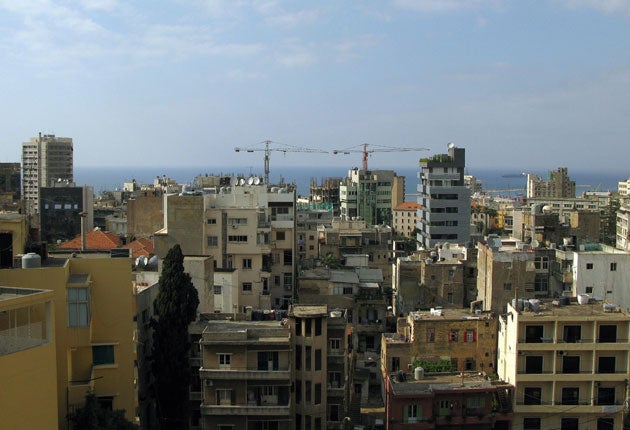Robert Fisk: Beirut is determined to kill its rich Ottoman past
Destruction of history

The streets are shrouded in bougainvillaea; the ancient yellow stones glow with warmth – thieved 100 years ago, I ask myself, from Beirut's Crusader castle? – and the roads ring with the voices of more than 1,000 children.
But what they are looking at is – if only the Lebanese recognised it – a national scandal. For most of the Ottoman buildings they are visiting are in a state of ruin, their roofs collapsing, their magnificent marble balconies cracked, their staircases propped up with wood, their frescoed windows shaking in the wind because their war-shattered glass has been replaced with torn plastic sheets. The final end of Ottoman Beirut – the crown and sceptre of the Sublime Porte of Constantinople – looks set to become another high-rise suburb, a developer's dream and proof yet again that the Lebanese, who have fought for generations to keep their country, care little about its history.
For years, I have looked at these buildings, driving past them in the civil war, listening to The Independent's driver, Abed, as he remembered a Beirut of cream and brown tramcars and cobbled roads and of an Ottoman rule that took his own father off to fight General Allenby in Palestine only days after his wedding. "That is the Palais Heneiné," he would say (built 1880 by a Russian count, once the US consulate to Ottoman Syria). "That used to be the Boustany School."
And I would look at the collapsing vestibule of this most famous and challenging of Beirut's educational institutions, the first secular school of Beirut (1863) for children of every religion – Maronite Christian, Sunni Muslim, Shia Muslim – its classrooms now decayed into run-down Pepsi parlours, its great goitered arches crumbling behind a concrete wall, the home now to stringy cats and garbage. Christian Boutros al-Boustany was one of the great intellectuals of late 19th-century Lebanon, publisher of scholarly volumes and editor of a famous Arabic dictionary and encyclopedia. His schoolteachers' homes now sprout trees. Round the corner is the home (1880) of Selim Dahesh, author of 150 books, now commemorated in the Dahesh Museum of Art in Manhattan, where 88-year-old Zeina, daughter of one of Lebanon's most famous painters, sits by cracked windows, looked after by neighbours, living most of her time in a marble kitchen which should be in a ghost story, and greets each of her visitors with mesmeric eyes and arthritic hands. Can we let all this be smashed down in a fit of avarice by the greed of Lebanese big business?
The Beirut suburb of Zokak el-Blat was once the most important street in Beirut, an upmarket Ottoman thoroughfare of merchant homes which the sultans built as the first paved road to Damascus, the start of the city's fame, all road tiles and piped water, before the steam locos arrived at the end of the 19th century. It's not just Ottoman. A gaunt concrete gateway leads to the American Printing School, the first Western publishing centre in Beirut, every metal wall sheet imported from America in 1920, its three storeys of shelving a Meccano set of stairs and a single iron lift. The staff still pack books for distribution, children's fairy stories lying beside a pocket edition of Pascal's Pensées.
Already the high rises of Solidere, the company rebuilding central Beirut, are creeping nearer, the completed downtown work a painstaking renovation of the old French colonial mandate capital at the expense of its Ottoman port buildings. But it's good to see Mona Hrawi – widow of President Elias Hrawi who recommended civil marriage to the applause of all in Lebanon except the feuding bishops and imams who suddenly joined in ecclesiastical alliance to crush the idea because their inheritance of cash from funerals and divorce settlements was endangered – leading a chorus of children through these streets. Her National Heritage Foundation is trying to protect this bit of Beirut's damaged past, assisted by Rima Shehadeh whose own Ottoman home is a masterpiece of restoration.
But should the past always be protected? The problem is that property has no value in Beirut's venal society – only land; a three-storey palace is not worth protecting when a ball and chain will make room for a 20-storey apartment block. Heritage protection laws are still those of the 1920-46 French mandate. Long ago, balconies and atriums with painted ceilings lost their views of the sea and now look out upon the hot concrete of glass and steel apartments. A couple of days ago, I wandered past stone models of harps in front of overgrown gardens, of magnificent, twisted fin de siècle balcony railings.
And the same day, I opened the Beirut papers to find that the Lebanese are holding conferences on the massive earthquake which all agree is soon to afflict Lebanon – the last entombments of its population being in the sixth and 16th centuries. Ottoman buildings contain so much wood that they will withstand the shocks, they say, and the newly built millionaires' colossi have absorbers at their roots. It's those who live in apartment blocks of the 1950s, thrown up without such earthquake-proof protection, most dangerous if they have no basements and if you live on the first or second floors, who will die. And I realise that I live on the seafront in a 1958 building, on the second floor. And it has no basement. I promise I'll soon return to the scandal of the heritage of Ottoman Beirut.
Unless...

Join our commenting forum
Join thought-provoking conversations, follow other Independent readers and see their replies